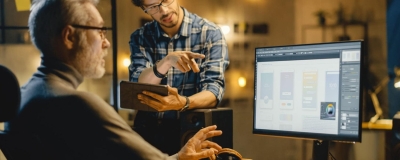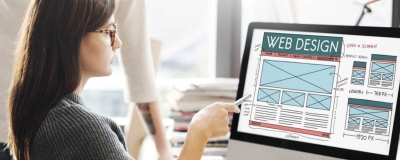Web Design Trends 2024: What’s In, What’s Out, and What’s Essential
As we enter the year 2024, the ever-changing field of web design continues to progress, offering fresh opportunities and obstacles for designers and businesses. Keeping up with the ever-changing digital landscape is imperative, and having a deep understanding of the most recent developments in web design is vital for crafting influential and user-focused websites. In this blog post, we will thoroughly examine the web design trends that are poised to take centre stage in 2024. We will explore the current popular styles, the ones that are losing traction, and the key elements necessary for crafting a captivating online identity.
What’s In: The Latest Web Design Trends
Immersive 3D Elements
An intriguing trend in 2024 is the use of immersive 3D features into web design. With the rapid progress of technology, designers have gained the ability to produce captivating 3D visualisations that significantly boost user engagement and offer a more immersive and interactive experience. Incorporating three-dimensional components, such as 3D product presentations and website environments, has the potential to enhance the overall aesthetic and user experience.
Dark Mode for Accessibility
Dark mode has evolved from a passing trend to a widely accepted design standard. In 2024, the focus is not solely on beauty, but also on ensuring accessibility. Dark mode effectively minimises eye strain and enhances reading, particularly in environments with limited lighting. Websites that offer a dark mode option give customers with a personalised experience, accommodating their tastes and improving overall usability.
Minimalistic Micro-Interactions
Micro-interactions have been steadily growing in popularity, and in 2024, there is a strong emphasis on incorporating minimalistic designs. Delicate animations and interactions, like button hovers, scrolling effects, and icon transitions, contribute to a sense of refinement without overpowering the user. These micro-interactions play a crucial role in creating a smooth and pleasurable surfing experience, enhancing the website’s memorability.
Voice User Interface (VUI) Integration
Given the increasing popularity of voice-activated devices, it is crucial to incorporate Voice User Interface (VUI) features into web design. Websites that utilise VUI not only appeal to a broader range of users but also offer a hassle-free and user-friendly surfing experience. Incorporating voice search, commands, and navigation options can distinguish a website in terms of accessibility and innovation.
Augmented Reality (AR) Experiences
With the ongoing maturation of AR technology, the integration of augmented reality experiences into web design is poised to become a noteworthy trend in 2024. AR can be utilised by brands to enable people to visually experience products in their actual surroundings prior to making a purchasing choice. AR significantly boosts user engagement and produces distinctive online experiences by offering virtual try-ons for fashion products and enabling the visualisation of furniture in a room.
What’s Out: Trends to Bid Farewell to in 2024
Excessive Use of Stock Photos
In 2024, the importance of authenticity cannot be overstated, as the use of generic stock pictures is gradually diminishing. Users are naturally attracted to authentic and unique visuals that accurately represent the brand’s identity. Designers are increasingly shifting their focus from using overused stock imagery to opting for creative photography, illustrations, and graphics that have the ability to convey a distinctive narrative and deeply connect with the intended audience.
Overly Complex Navigation Menus
In 2024, web design trends prioritise simplicity and user-friendliness. Navigation menus that are excessively intricate and inundate consumers with a multitude of choices are gradually becoming outdated. Designers are increasingly choosing simple navigation systems that prioritise clarity and user-friendliness. An intuitive navigation system plays a crucial role in improving the overall user experience and motivates visitors to effortlessly explore the website.
Flashy and Distracting Animations
As animations continue to be popular, there is a noticeable shift from flashy and obtrusive animations to more sophisticated and intentional motion design. Subtle animations that have a useful purpose, like directing users through a website or displaying key information, are preferred over excessive and attention-grabbing animations that can disturb the user experience.
Non-Responsive Designs
In today’s digital age, it is imperative for websites to be accessible across all devices. Designs that are not adaptable have become outdated and irrelevant. Given that the majority of internet traffic originates from mobile devices, it is imperative to have a responsive design. This is not merely a passing trend, but rather an essential requirement. Google’s focus on mobile-first indexing highlights the significance of guaranteeing a smooth experience on different screen sizes.
Autoplaying Videos with Sound
Autoplaying movies with sound have the potential to be obtrusive and disruptive to the user experience. In 2024, designers are moving away from this approach, acknowledging that people have a preference for being in charge of their online experience. By integrating video components with muted autoplay or offering a straightforward and user-friendly option to enable sound, users are empowered to select their preferred level of participation.
What’s Essential: Core Principles for Web Design in 2024
User-Centric Design
User-centric design continues to be the fundamental principle of successful web design in 2024. To create a website that truly connects with users, it is crucial to have a deep understanding of the target audience, their specific needs, and their behaviours. This knowledge forms the foundation for designing a website that effectively engages and resonates with people. The design process can be enhanced by incorporating user research, usability testing, and continuous feedback loops. This approach helps to create a smooth and user-friendly experience.
Performance Optimization
In today’s fast-paced digital landscape, the performance of a website is of utmost importance. Sluggish websites have the potential to deter users and have a detrimental effect on search engine rankings. To ensure fast page load times, it is necessary to optimise images, leverage browser caching, and employ content delivery networks (CDNs). Performance optimization is a practice that not only focuses on the needs of the user but also plays a crucial role in improving SEO.
Accessibility Compliance
Web accessibility has transitioned from being a passing trend to becoming an essential requirement. Guaranteeing the accessibility of a website to users with diverse abilities is not only morally right but also legally required in numerous jurisdictions. Designing with accessibility in mind entails the creation of a website that is easily navigable and comprehensible for those with impairments, especially those who rely on assistive technologies.
Security Measures
In a time when the frequency of cyber threats is increasing, it is imperative to prioritise security without question. In order to protect user data and maintain a positive reputation, it is crucial to implement HTTPS, conduct frequent security audits, and stay up-to-date with the newest security best practices. A secure website not only safeguards user information, but also fosters a sense of confidence among visitors.
Content-First Approach
Content continues to be of utmost importance, and it is crucial to prioritise a content-centric approach for successful web design in 2024. Taking into consideration the content when designing guarantees that the arrangement and visuals harmonise with the messaging and objectives of the website. By prioritising clear and succinct information, utilising hierarchy to orient consumers, and incorporating whitespace for readability, we can create a cohesive and engaging user experience.
Conclusion
As we progress through 2024, web design is undergoing constant evolution, fueled by technical developments, consumer preferences, and industry norms. By staying updated on the newest trends, discarding outdated techniques, and sticking to important principles, designers and businesses can confidently create websites that not only fulfil the expectations of today’s users but also predict the future needs. This approach empowers them to stay ahead of the curve and ensure their designs are both relevant and forward-thinking. Undoubtedly, the success of web design endeavours in the future will be shaped by embracing innovation, prioritising user-centric design, and retaining a strong commitment to excellence.












